For the successful all-round development of a child, activities to develop fine motor skills of hands are of great importance. One of the types of such activities are applications from colored paper, templates for which are developed by methodologists taking into account the characteristics of age groups of preschoolers.
It is important that the complexity of the task corresponds to the child’s age, that the lessons are conducted systematically, gradually becoming more difficult, and that they take place under the supervision and with the help of adults.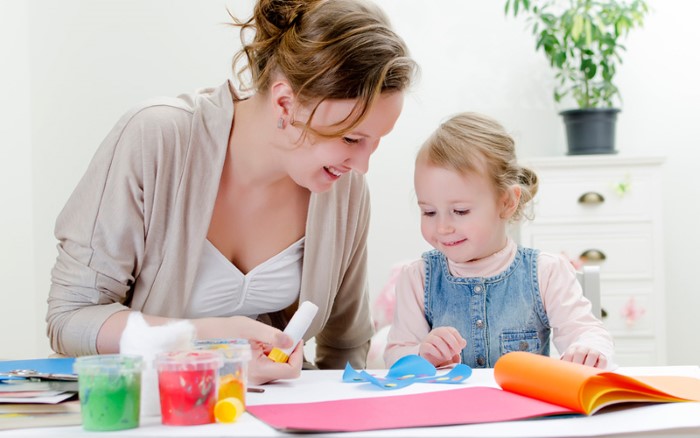
What are the benefits of template applications for development?
Paper applications – a creative process through which children learn about the world around them and acquire many skills. In addition to developing fine motor skills of the hands, this includes coordination of movements, studying colors and their combinations, understanding composition, familiarization with various materials and textures, developing observation, imagination, and fantasy.
Working on applique in a group promotes organization, endurance, and accuracy. It is also necessary to note the development of spatial imagination: while doing applique, children create a whole from several components and, conversely, learn to divide the whole into parts.
Scientists have proven that in the cerebral cortex the center responsible for fine motor skills is located next to the speech center and contributes to the development of speech skills.
Types of appliques by template
There are three main types of applique:
- subject - the cut out parts have a simple, clear shape and proportions, an image is created that is not associated with any plot;
- plot-thematic – correspondence to a specific plot (taken from a fairy tale or invented independently);
- decorative – decorating postcards and photo frames with patterns of geometric shapes.
Simple applications for children 2-3 years old
Simple applications from colored paper using templates can be done from the age of 2. However, some experts believe that children from 1 year old can do feasible tasks.
Initial lessons involve gluing pieces of paper onto a sheet of paper in any form. At this stage, the child must understand and remember the basic actions: spread, turn over, apply, smooth. The little ones are still attracted by the process itself, they will strive for the result later.
At the second level of complexity, templates are used. The child must also place the elements chaotically, but within the contour, and a certain image emerges.
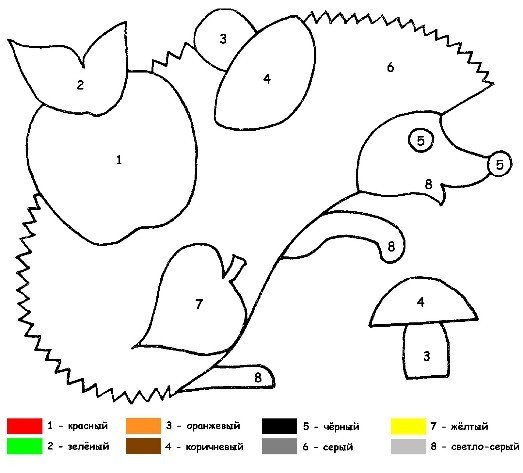
A template is a schematic image of a future picture, drawn or printed on a printer. Simple templates for colored paper appliqués can be, for example, a Christmas tree with balls, a tree with apples, and others.
For such work, you need to prepare elements: balls, apples, etc. The child must determine how to arrange them on the templates.
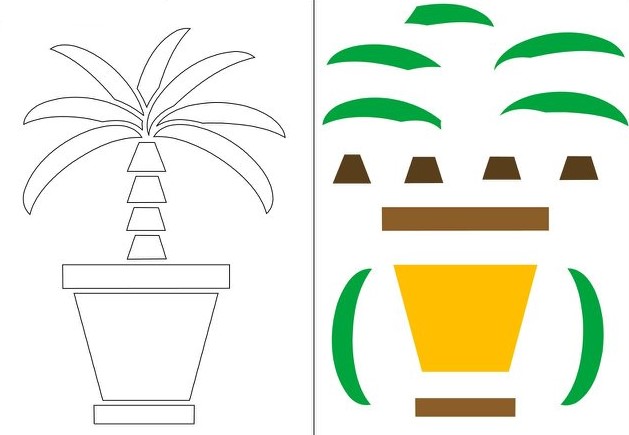
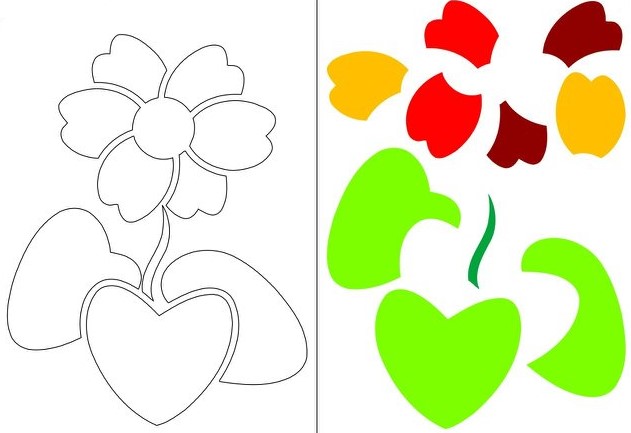
For small children, it will be interesting to make a simple tear-off applique. The child watches as an adult tears paper into long strips, then tears them into shreds himself. These pieces need to fill the outline.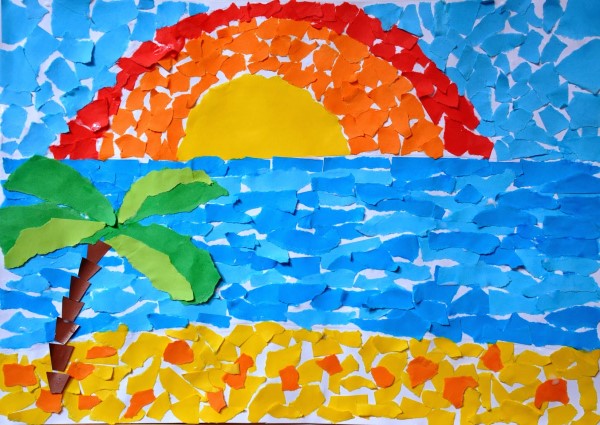
If the child wants to tear the paper himself, then from these uneven, awkward strips you can also make an applique, for example, grass. Ants are drawn with finger paints.
Then the task becomes more complicated: you need to get the element to a specific place on the template or drawn outline. Thus, using cut out circles, the image of a caterpillar is made. At this stage, children are interested not only in the process, but also in the result.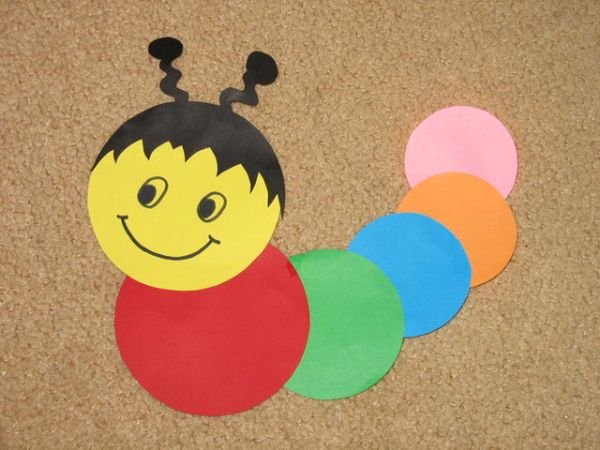
When making appliqués from colored paper using templates and contours with children under 3 years old, prepared cut-out elements are used.
A three-year-old child can already be taught the skills of working with scissors with rounded ends.
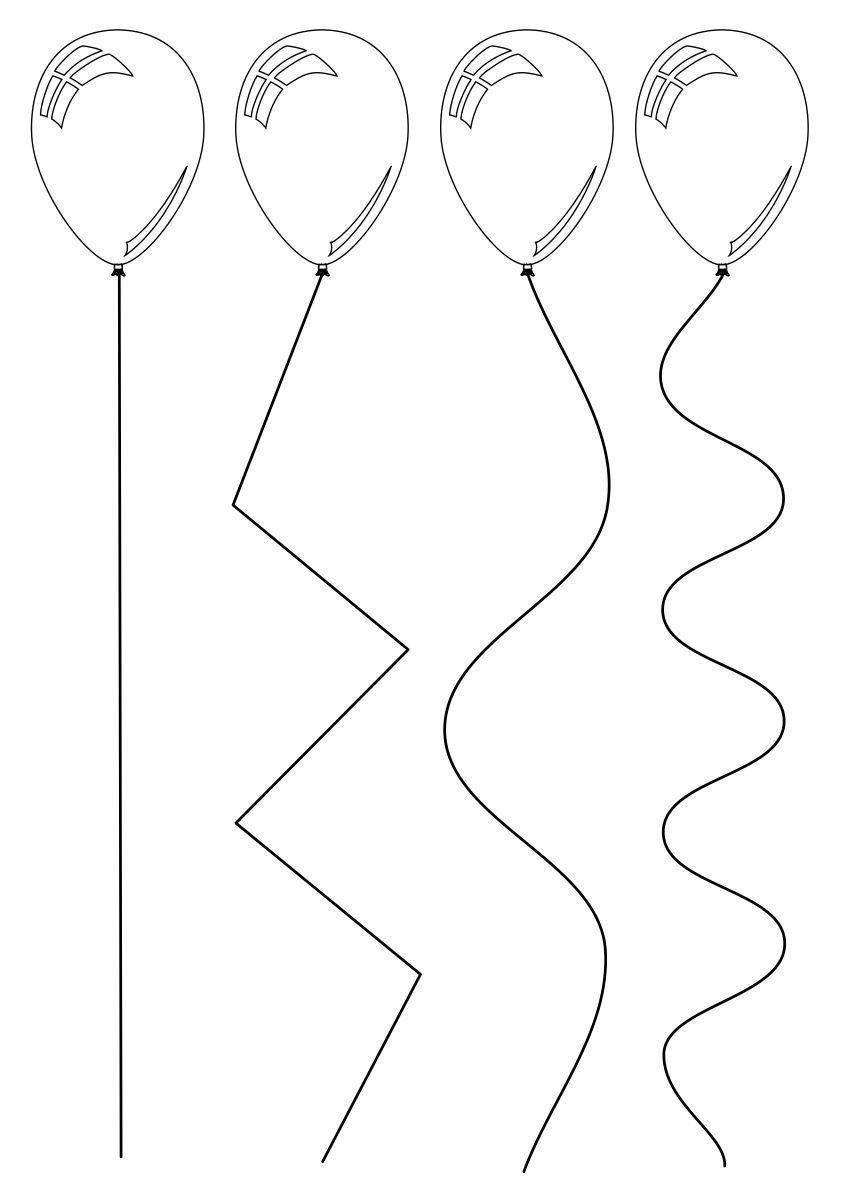
At the same time, it is necessary to explain how to hold scissors and paper correctly so as not to get hurt. You need to start with straight cuts, then work on bends and roundings.
At this age, children are already able to create simple plot pictures. Elements glued to a template allow you to create a specific image.
The background for the applique can be a drawn outline with partially drawn elements. For example, children can populate a template aquarium with algae and stones on the bottom with inhabitants: fish, jellyfish, etc.
An interesting activity can be connecting and gluing a cut picture. If the child copes with such a task easily, it is recommended to complicate it: add raindrops to an umbrella, glue windows to a house with an attached roof. Such activities develop imagination, observation, a sense of proportion.
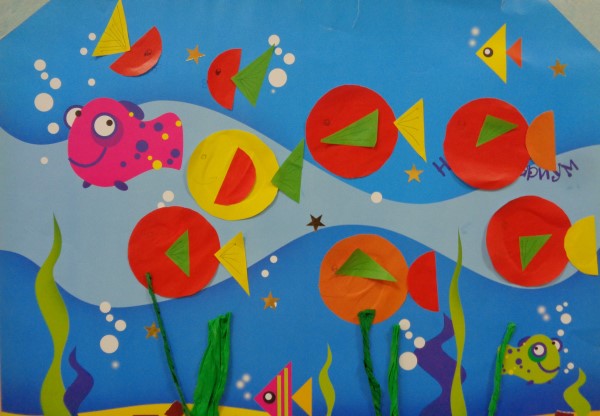
Applications for children 4-5 years old
At this age, colored paper appliques and templates for them become more complex. By preparing, together with an adult, elements for a future picture, the child shows more independence: cuts out, selects colors and, thus, gets an idea of composition.
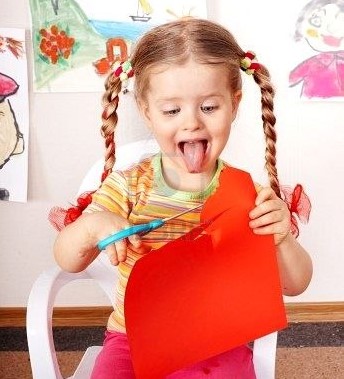
Such activities develop logical thinking and allow one to express creative abilities.
For children aged 4-5, a fun activity is making cards that they then give to their parents and friends.
The base is folded in half and elements are glued inside the card to form a plot picture.
The templates developed by specialists are only examples indicating the direction of work.
Parents and educators can contribute their own ideas. For example, using a cut-out outline of a baby's palm in an applique - such pictures cause amazement and delight in children.
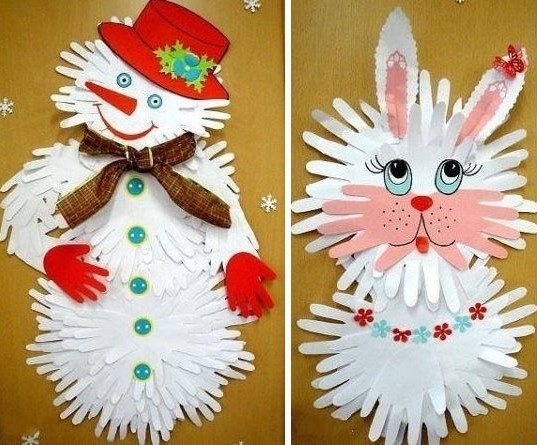
The technique of applique using only circles reveals to the child the relationship between parts and the whole.
Developing the child's creative imagination, you should show him various techniques for working with paper: for example, folding it like an accordion. For such a picture, you need to prepare a base, apply contours. The gluing process is also complicated.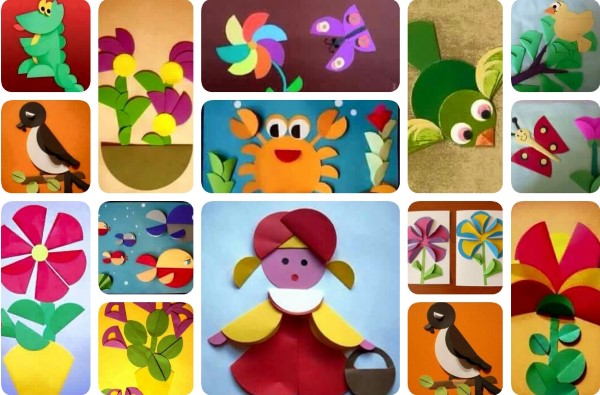
Complex applications for children 6-7 years old
Children of senior preschool and primary school age already have certain skills.
During this period, classes in colored paper applique using templates help further develop fine motor skills, thinking, memory and concentration, and develop the ability to plan one’s activities.
An important circumstance is that the child foresees the final result of his work.
At this age, children develop the skill of cutting out individual parts and whole silhouettes, symmetrical elements from paper folded in half, as well as the ability to create compositions and correctly arrange individual parts on a base.
At this stage, children study color combinations, analyze and compare details. The texture of the material also becomes varied: in addition to regular colored paper, crepe paper (crinkled), chalky (glossy), textured (embossed or velvet-imitating), and foiled paper are used.
During this period, you can move on to volumetric symmetrical compositions.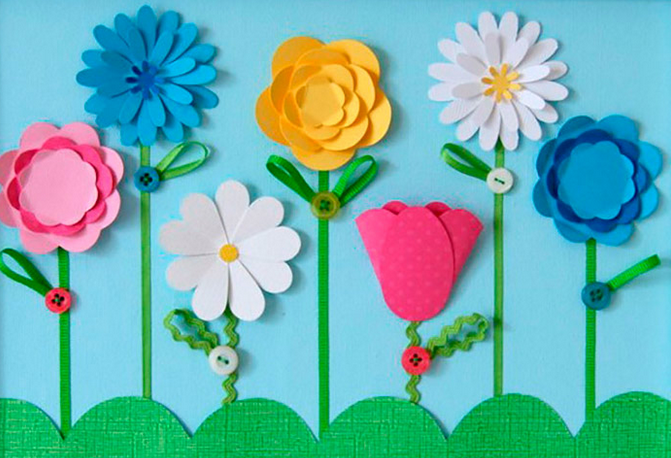
To complete such a task, the templates (clouds, balloons) are cut out in the usual way. Then two identical templates are folded in the center and fastened together (can be sewn). The prepared elements are glued to the base.
To make a three-dimensional bird, the template is folded in half and glued, except for the wings, which are folded along the dotted line.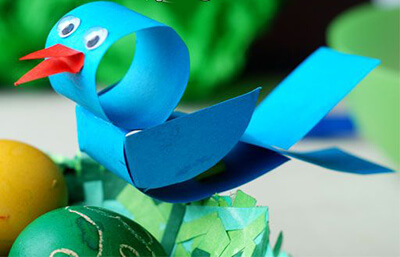
The resulting product can be glued with one side and a wing to the base (as an applique) or turned into a craft by tying it to a thread and hanging it on a branch.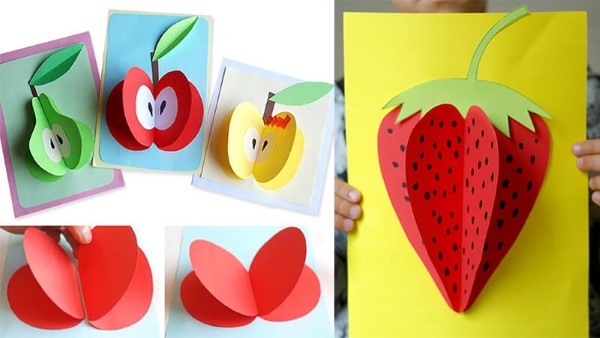
Having mastered the basics of composition at the previous stages, children aged 6-7 are able to create entire paintings – landscapes, still lifes, using ready-made templates for appliques from colored paper or making them with the help of a teacher or parents.
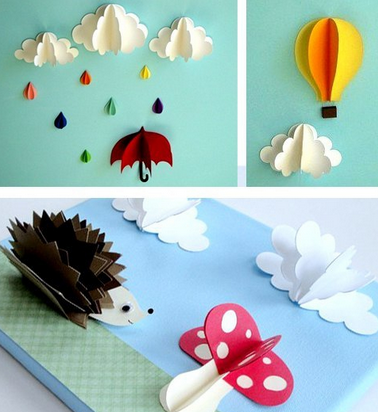
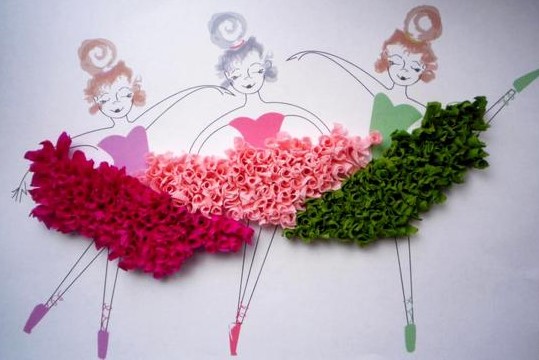
Applications using a disposable plate
Disposable plates are a convenient material with which you can create original and beautiful compositions. Made of polystyrene or cardboard, in different colors, with different embossed patterns, they can be both the basis for an applique and elements for it.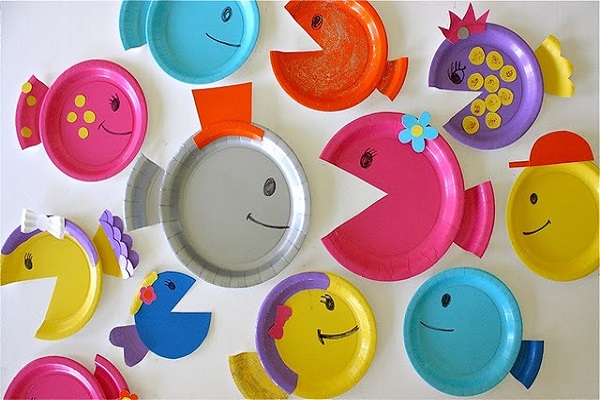
Children from a young age can be involved in making applications from colored paper on a disposable plate using templates. On a prepared colored background, children place simple elements in the form of a pattern.
A more complex option is to use two or more colors for the background and more complex elements. Children aged 6-7 years already make thematic compositions on plates or use them as material for individual elements.
Examples of increasingly complex plate applications: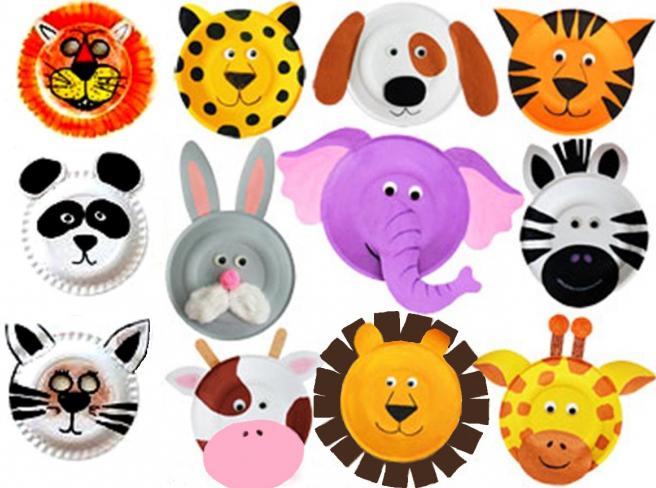
Combined applications
When making appliques from colored paper, templates can be diversified by combining different materials.
Cereal applications
This type of applique can be done even with small children. The work algorithm is as follows: an adult applies glue to the prepared drawing, the child sprinkles cereal on it and presses it lightly with a finger.
The remaining unstuck grains need to be shaken off. This activity teaches the child attentiveness and accuracy.
Older children can use different types of cereals. In this case, the glue is applied alternately to individual areas. To make the picture more colorful, it is recommended to pre-paint the cereals with gouache in different colors. You can use your child's own drawing as a template; this stimulates him and inspires him.
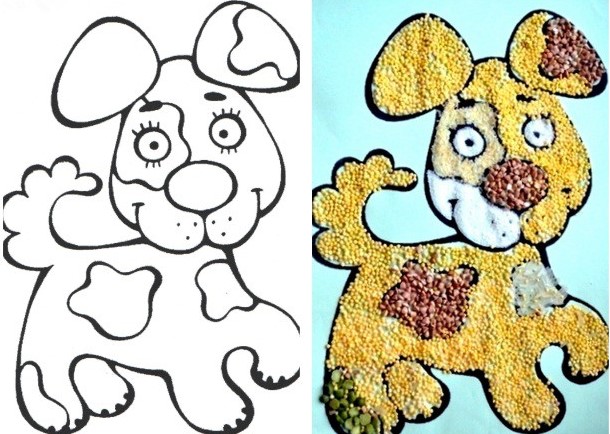
Button appliques
To make such an applique, preliminary preparation is necessary. Having studied the drawing and chosen the colors, the child, with the help of adults, selects buttons of the appropriate color and size. Then they should be laid out on the drawing to imagine the desired result, and begin gluing.
For younger children who do not yet have the necessary skills, you can apply a pattern to a layer of plasticine - the child will attach the buttons by pressing. This technique is also applicable when working with cereals.
For combined applications, cotton wool, napkins, eggshells, natural materials – leaves, petals, seeds and much more are also used.
Multilayer applications
Multilayer (overhead) appliqués made of colored paper or other materials are made using templates developed or made independently.
Such work develops spatial imagination, educates aesthetic taste. They are made of paper, fabric, leather, felt - the main thing is that the edges of the material do not crumble.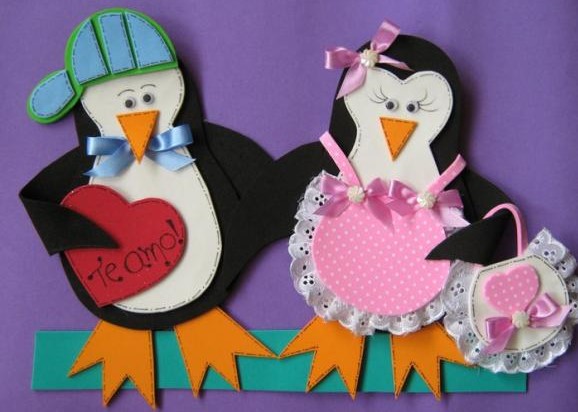
Multilayer appliques, like other varieties, come in varying degrees of complexity. For little ones, this is simply gluing the parts onto each other. By attaching the elements only on one edge, you can create a three-dimensional effect.
More complex appliques are characterized by a large number of details and require good scissor skills, a sense of proportion and color to make them.
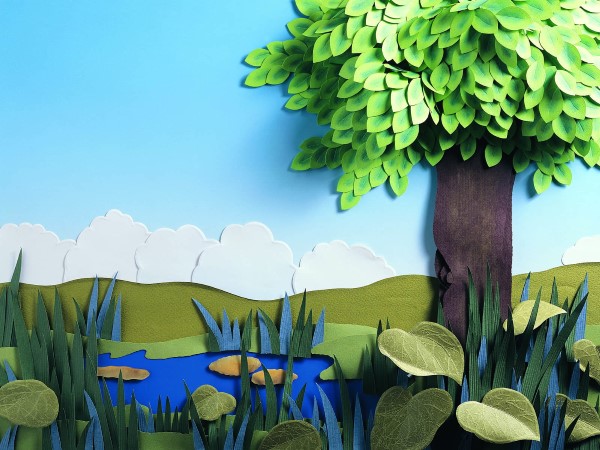
Older children, with developed fine motor skills of their hands, who have the skills to make complex parts, create real works of art – unusual compositions and even portraits. Light and shadow effects give them a special color.
Multilayer applique is a truly creative process, in which the child's imagination and artistic abilities are revealed. It is necessary to think through the image, color scheme, sequence of actions, so such work implies a certain level of intelligence.
Applications from pieces
Applications from cut or torn pieces of colored paper using templates are a fairly simple type, even small children can do them. You need to apply a drawing to the base sheet. In addition to ready-made templates, you can use children's coloring books or come up with a sketch yourself.
The production of applique elements is carried out together with the child - small children are happy to tear paper into pieces. If you already have skills in working with scissors, you can allow these elements to be cut out.
An important detail: the younger the child, the larger the fragments should be.
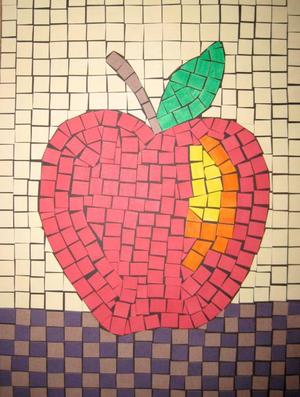 Having selected the necessary colors, you can start gluing. The glue is applied not to small parts, but to the template, in sections.
Having selected the necessary colors, you can start gluing. The glue is applied not to small parts, but to the template, in sections.
When working with toddlers, this process is carried out by an adult; older children apply the glue themselves with a brush. When gluing pieces of paper, the child must precisely hit the outline.
A variation of applique from pieces is end-graining. This technique is quite complicated, but children aged 6-7 can do it, especially when working together.
To master the technique of end-grain cutting, teachers and parents are offered master classes on this topic.
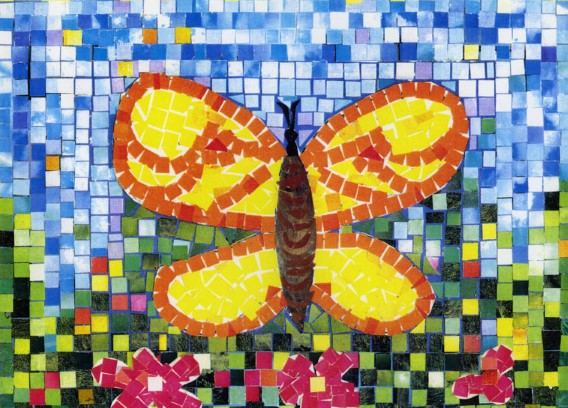
Autumn themed appliques
Bright colors of autumn make it possible to create colorful pictures of autumn nature. For applications on this theme, both colored paper and natural materials are used: multi-colored leaves, petals of late flowers, seeds, ears of corn, twigs and other objects.
When making autumn-themed appliqués from colored paper using templates and free composition, the main attributes are preserved - flowers, mushrooms, fruits, acorns, tree silhouettes are cut out and painted. A mandatory component is autumn leaves.
When working with natural material, it needs to be prepared. The collected leaves need to be pre-aligned and dried under a press. If the leaf needs to be given some shape, then a fresh leaf is used for this, which is then dried.
For collages and mosaic paintings, you can prepare cardboard templates onto which the elements are glued.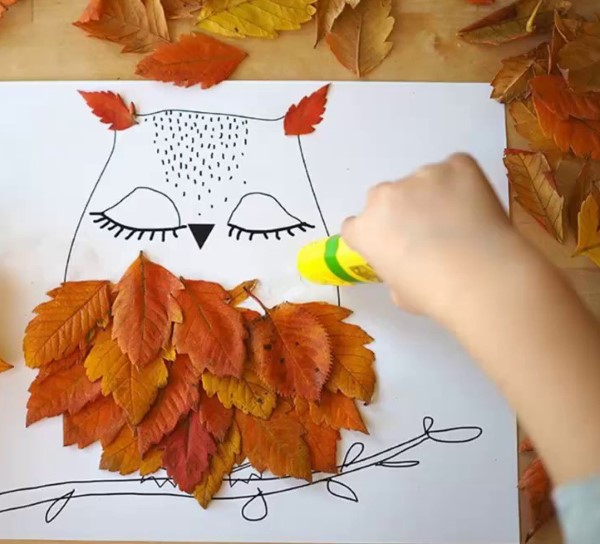
Autumn nature is a fertile ground for children's imagination. Leaf appliques placed in a photo frame will decorate any interior.
Autumn lanterns will also be an effective decoration. To do this, a glass vessel is pasted on the outside with multi-colored leaves (paper or natural), and a small candle is placed inside.
Winter themed appliques
To create winter and, in particular, New Year's appliqués, any of the described techniques are used, depending on the age of the children.
The most common type of winter appliques are snowflakes - this is a subtype of silhouette applique. It is recommended to fold the sheet correctly, cut the edge and sharp corner, make cuts first on regular paper - this is how the skill is developed.
In addition, the room is decorated with pendants made of such snowflakes. Thin, airy snowflakes can be glued to windows and other surfaces.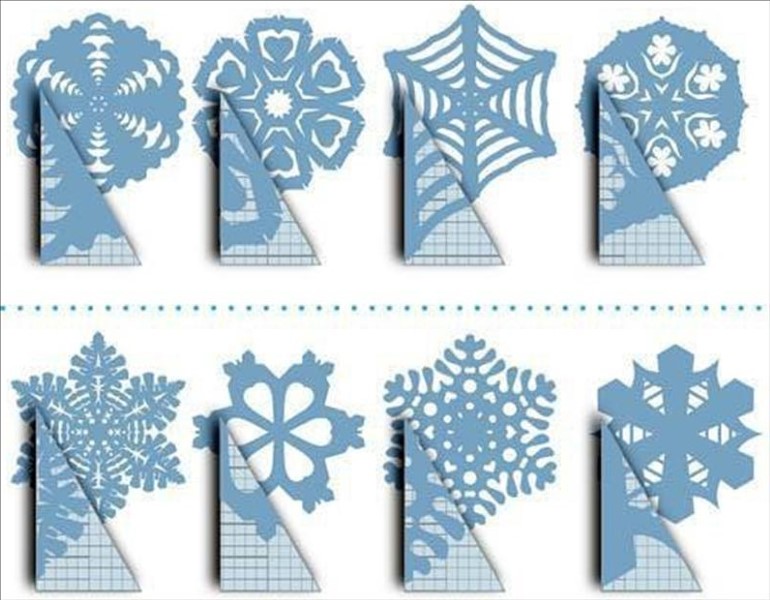
For small children, it is better to prepare templates (circles with an outline applied) and make a tear-off snowflake from pieces. For flat, volumetric, multi-layer snowflakes, it is necessary to prepare patterns for cutting.
To make a traditional Christmas tree, kids use triangles of green paper, a snowman is made from white circles, and a teacher or parent helps to add details to the applique.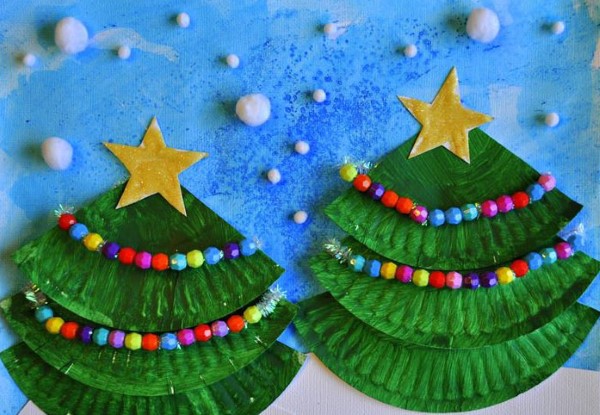
Older children can be offered to make a Christmas tree from strips of paper or create a picture of a winter forest using templates, using small pieces of paper or cotton wool.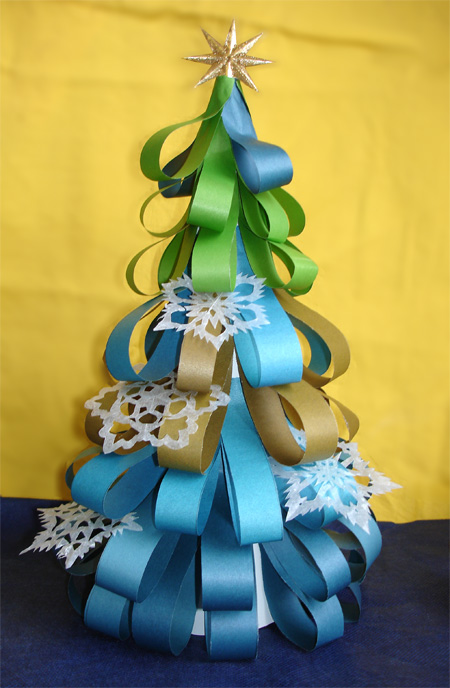
A Christmas tree made of paper balls looks bright and voluminous. For this, a template and elements are made of crepe paper. The main color is dark green, and multi-colored balls are made for the garland.
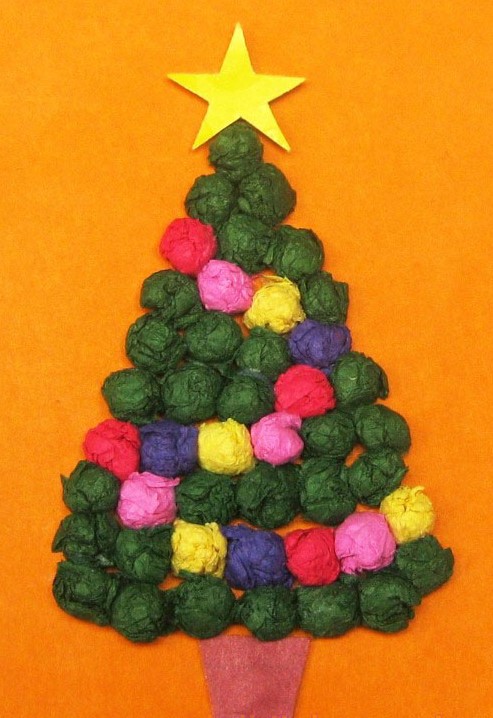
After applying glue to the template, it is recommended to first place the garland, then fill the outline with “needles” and complete the applique with a star and base.
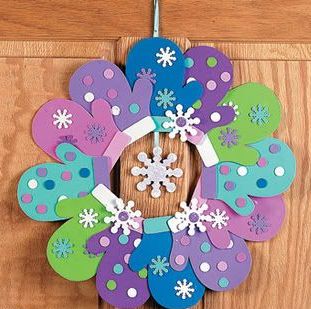
An interesting applique with images of winter accessories allows children to show their creative imagination.
The hat and mittens can be decorated with any ornament, animal figures, winter pictures, beads or rhinestones.
Cotton wool is used to imitate fur.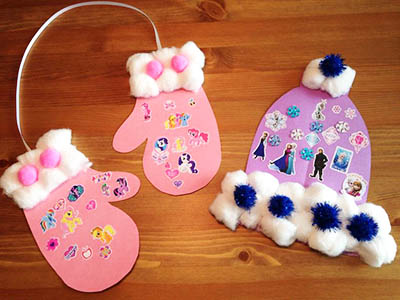
You can make a polar bear mask using a disposable plate. Cut holes in the plate for the eyes, cover the surface with pieces of paper, and use a disposable cup for the nose.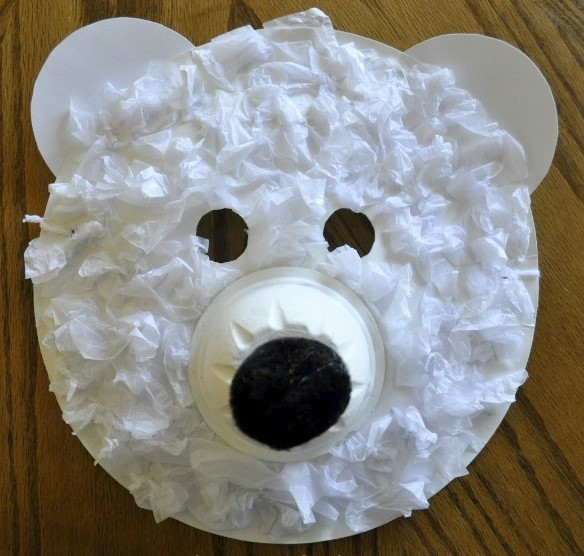
Older preschoolers and primary school students are able, under the guidance of adults, to create complex winter landscapes using mixed techniques.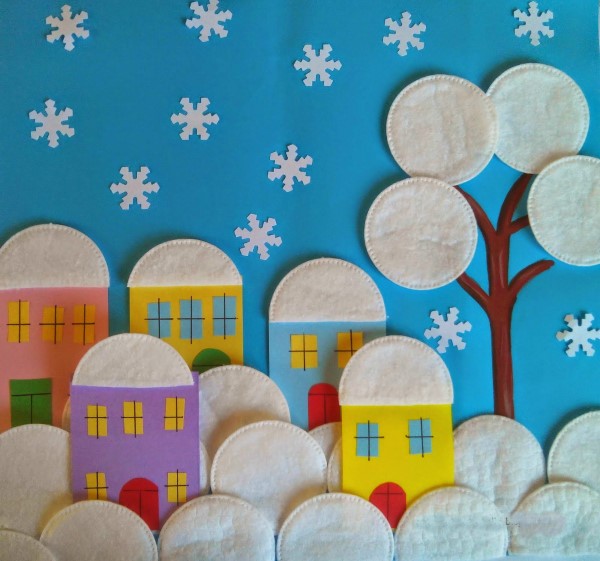
Spring-themed appliques
Snowdrops and lilies of the valley, starlings and blossoming trees – these signs of spring are traditionally used in children's appliques made of colored paper using templates. The youngest perform simple tasks, placing prepared elements on the contours. These same images can be complicated by adding pictures of spring nature.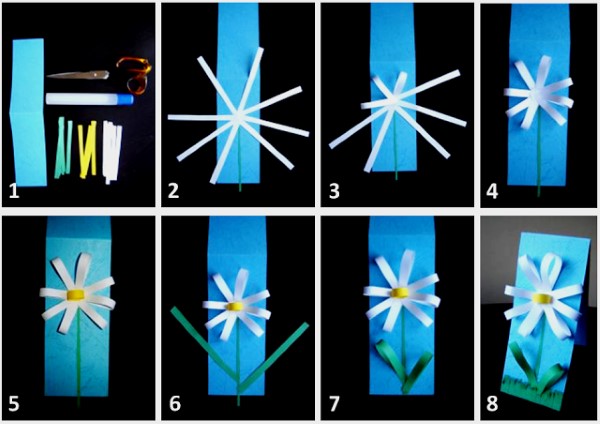
More complex compositions – voluminous, multi-layered, with a large number of elements – are created by children who have skills in working with glue, scissors, a brush, and using different techniques.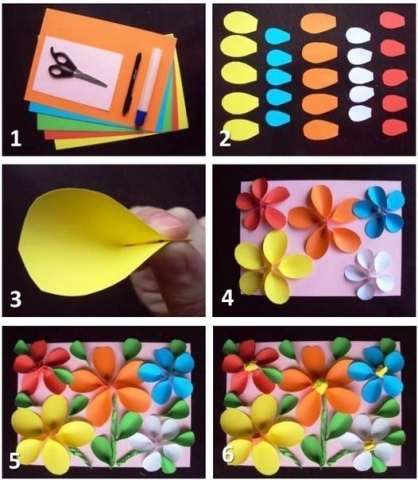
Lilacs in a cereal vase, a spring painting using drawing and applique techniques – these and many other ideas are offered by specialists to parents and educators for developmental activities with children.
Application is a visual activity. Having achieved the desired result, the child experiences aesthetic pleasure, thereby joining the world of beauty, the world of art. A simple and accessible way for children to create art works makes application one of the favorite types of developmental activities with children.

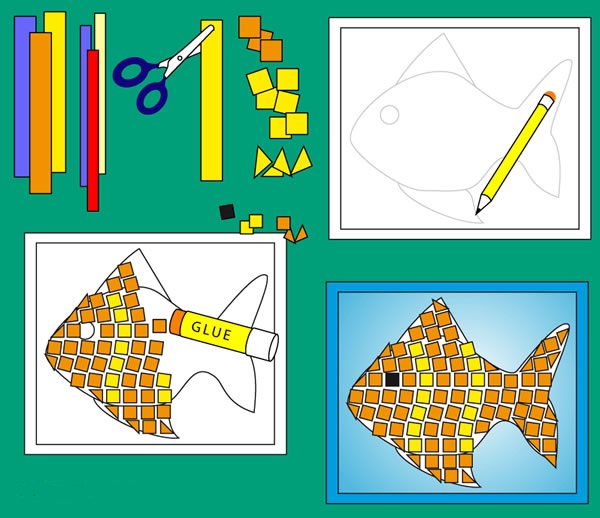
Very diverse types of applications, educational!!!
great - thanks for such wonderful material
Great - thanks for such wonderful material - useful and accessible!!!!!!
Applications that are needed! Thanks to the author!